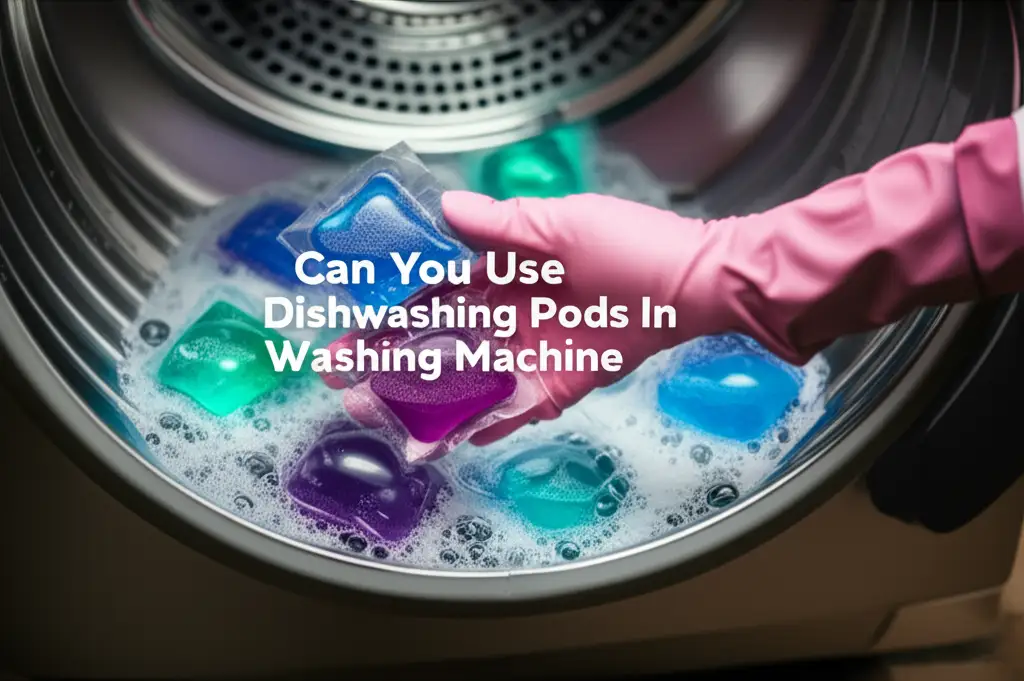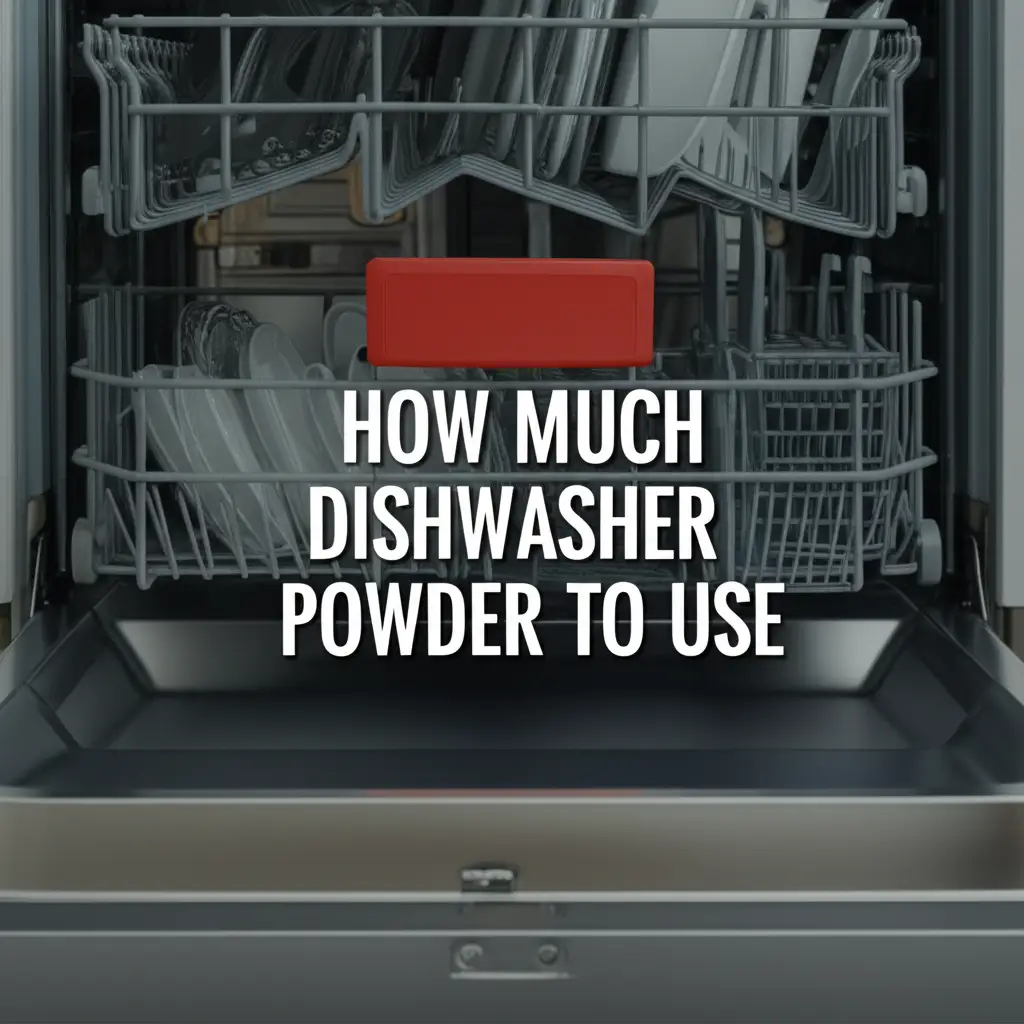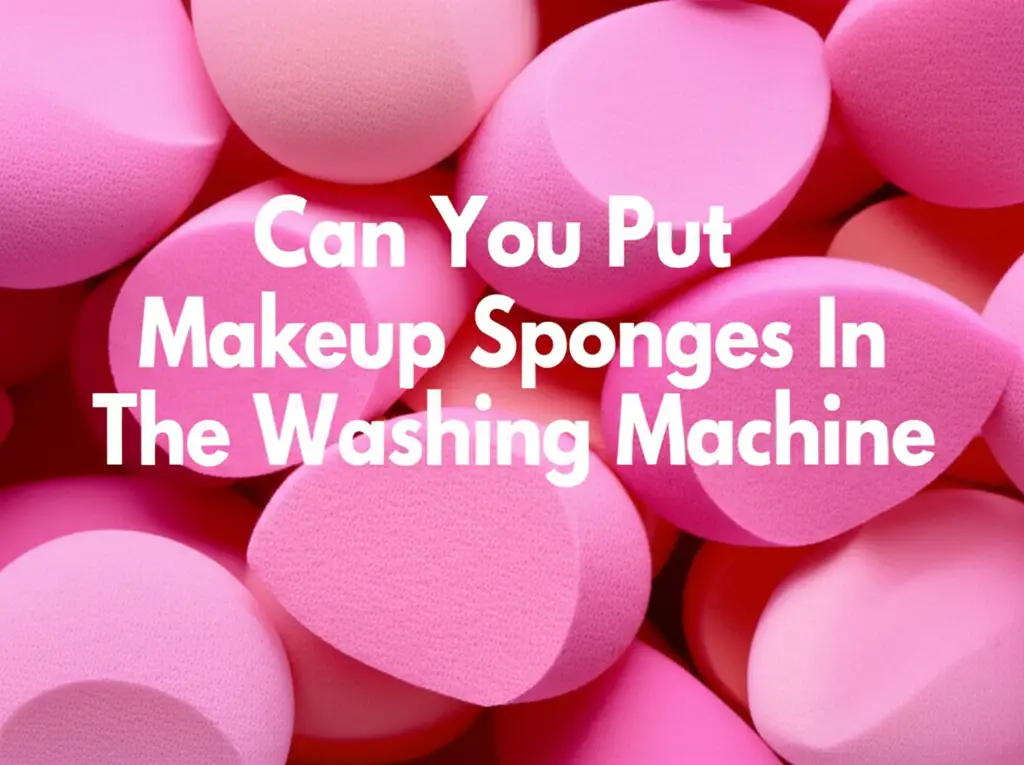· Liora Benning · Laundry & Home Care · 15 min read
Can You Use Dishwashing Pods In Washing Machine

Using Dishwashing Pods in Your Washing Machine: A Guide
Have you ever run out of laundry detergent and wondered if a dishwashing pod could work as a substitute? It’s a common thought, especially when you have a mountain of clothes to wash and no time to run to the store. The convenience of a pre-measured pod makes it seem like a quick fix for many cleaning tasks. However, the answer to “Can you use dishwashing pods in washing machine?” is not as simple as it might appear.
While both dishwashing pods and laundry detergents are designed for cleaning, their chemical compositions are very different. These differences are crucial for how they interact with specific appliances and materials. Using the wrong product can lead to unexpected problems, harming your clothes or even your washing machine. This article will explain why these two products are not interchangeable. We will explore the specific risks involved and offer clear advice on keeping your laundry fresh and your appliance safe.
Takeaway:
- Avoid using dishwashing pods in your washing machine. They are formulated for different tasks.
- Dishwasher pods create excessive suds. This can overflow your washing machine and leave residue.
- Harsh chemicals can damage fabrics. Dishwasher detergent is too strong for clothing fibers.
- Appliance damage is a risk. Suds can block sensors and pumps, leading to costly repairs.
- Always use proper laundry detergent. Choose products specifically designed for clothes washing machines.
No, you should not use dishwashing pods in a washing machine. Dishwashing pods contain different chemicals than laundry detergents. They produce far too many suds for a washing machine, especially for high-efficiency (HE) models. Using them can cause overflows, damage your appliance, and ruin your clothes.
Understanding the Difference: Dishwashing vs. Laundry Pods
It is easy to think that all cleaning pods are similar. After all, they both clean things, right? However, there is a big difference between dishwashing pods and laundry pods. Each type is made for a specific job. Understanding these differences helps us see why you should not mix them up.
Dishwashing pods are for cleaning dishes and cookware. They contain strong degreasers and rinse aids. These ingredients help remove tough food stains and leave dishes spotless. Dishwasher detergents are designed to work in high-heat environments with limited water and powerful jets. They create very low suds because too many bubbles would hinder the cleaning action inside a dishwasher.
Laundry pods, on the other hand, are for washing clothes. Their formula focuses on fabric care. They contain enzymes that break down dirt, stains, and odors on clothes. Laundry detergents also have ingredients that protect fabric colors and textures. They produce a controlled amount of suds. This allows clothes to tumble freely in the wash water. The suds then rinse away cleanly, leaving clothes fresh. Using dishwashing pods in washing machine can lead to many problems because of these fundamental differences.
The Problem of Excessive Suds in Your Washing Machine
One of the biggest issues with using dishwashing pods in your washing machine is the amount of suds they create. Dishwasher detergents are not designed to foam much. But if you put them in a washing machine, the churning action can make them create an enormous amount of bubbles. This happens because washing machines use a different water-to-detergent ratio and agitation method compared to dishwashers.
Imagine your washing machine filling with suds, growing bigger and bigger. These suds can quickly fill the entire drum. They can even overflow out of the machine’s door or detergent dispenser. This messy situation is not only inconvenient but also dangerous. Excess suds can create slick floors, posing a slip hazard. They can also get into your home’s drainage system. Excessive suds also prevent clothes from rubbing against each other, which is how they get clean. Instead, clothes simply float on top of the suds. This means your laundry does not get cleaned properly, no matter how much detergent you use.
Furthermore, modern high-efficiency (HE) washing machines are designed to use very little water. They also require detergents that produce very few suds. Using a regular laundry detergent that is not HE-approved can cause problems in an HE machine. A dishwashing pod is even worse. The massive amount of suds can trick the machine’s sensors. The machine might add more water to try to dilute the suds, or it might extend rinse cycles. This wastes water and energy. This is a common issue that can also happen if you use too much regular laundry detergent. For more information on what goes where in a washing machine, check out our guide on what goes where in a washing machine.
Risks of Appliance Damage from Dishwasher Pods
Using dishwashing pods in washing machines carries serious risks for the appliance itself. Washing machines are complex devices with many moving parts and sensitive components. They are engineered to work with specific types of cleaning agents. Dishwasher pods can cause significant harm to these systems.
Excessive suds from dishwasher pods can get into places they should not. They can clog the drain pump. They can also interfere with the machine’s pressure sensors. These sensors detect water levels and suds. If they are covered in suds, they cannot work correctly. This can lead to the machine malfunctioning, not draining properly, or getting stuck in rinse cycles. A clogged pump might require professional repair or even replacement. To learn more about compartment usage, see our article on what are the compartments on a washing machine.
Moreover, the chemicals in dishwashing pods are harsher than laundry detergents. They are designed to cut through tough grease and dried food on hard surfaces like dishes. These chemicals can be corrosive to the rubber seals and plastic parts inside a washing machine. Over time, repeated exposure can cause these components to break down. This leads to leaks or other mechanical failures. Such damage can be expensive to fix. In some cases, it might even mean you need a new washing machine. To prevent such issues, always use detergents approved for your machine type. For insights into general appliance maintenance, you might find our guide on how to clean LG HE washing machine helpful.
How Dishwashing Pods Can Harm Your Clothes
It is not just your washing machine that is at risk. Your clothes can also suffer significant damage from dishwashing pods. Laundry detergents are formulated to be gentle on fabrics while still effectively removing dirt. Dishwasher detergents have a different goal: powerful cleaning for hard surfaces. This difference makes them unsuitable for fabric care.
The strong chemicals in dishwashing pods can be very harsh on clothing fibers. They might strip away fabric dyes, causing your favorite garments to fade quickly. They can also degrade the integrity of the fabric. This leads to clothes becoming stiff, brittle, or even developing holes over time. Imagine pulling out a sweater that feels rough and looks dull after a wash. That is a common outcome when using the wrong detergent.
Another major problem is residue. Dishwasher pods contain agents designed to prevent water spots on dishes. These same agents, along with the other harsh chemicals, can leave behind a sticky or powdery residue on your clothes. This residue is difficult to rinse out, especially with the excessive suds problem mentioned earlier. Clothes might feel gummy or have a strange texture. This residue can also irritate sensitive skin. Repeated washing with dishwashing pods can ruin your wardrobe. It is always best to use products specifically made for laundry to protect your clothes. To avoid issues like residue or clogs, it’s worth understanding potential problems like can dishwasher pods cause clogs in their intended appliance, which highlights the strength of their formulation.
The Correct Way to Detergent Your Laundry
Knowing how to properly detergent your laundry is key to clean clothes and a healthy washing machine. Forget about using dishwashing pods in washing machine. Always opt for detergents specifically made for laundry. There are several types of laundry detergents available, and choosing the right one depends on your machine and preferences.
Types of Laundry Detergent:
- Liquid Detergent: This is very popular and dissolves well in all water temperatures. It is often good for pre-treating stains.
- Powder Detergent: This is usually more economical and effective on heavily soiled items. Make sure it dissolves completely to avoid residue.
- Laundry Pods (Packs/Capsules): These are pre-measured, convenient, and mess-free. They dissolve quickly in water.
- High-Efficiency (HE) Detergent: If you have an HE washing machine, you must use HE detergent. These produce very low suds and are formulated for minimal water usage. Look for the “HE” symbol on the package. Using non-HE detergent in an HE machine can cause excessive suds and machine problems.
Where to Add Detergent: Most washing machines have a detergent dispenser drawer. This drawer usually has specific compartments for liquid detergent, powder detergent, fabric softener, and sometimes bleach. Refer to your washing machine’s manual to understand which compartment is for what. For more guidance on what to add to your washing machine, consult our article on what to add to washing machine. If using a pod, simply place it directly into the drum before adding clothes. Do not put it in the dispenser drawer, as it may not dissolve properly.
Always follow the detergent manufacturer’s instructions for the correct dosage. Using too much detergent, even the right kind, can lead to residue on clothes and issues with your washing machine. Using too little might not clean your clothes effectively. Proper detergent use ensures optimal cleaning results and prolongs your appliance’s life. You can also explore when to add other products like when to use fabric conditioner in washing machine for best results.
What If You Accidentally Used a Dishwashing Pod?
Mistakes happen. If you accidentally used a dishwashing pod in your washing machine, do not panic. The most important thing is to act quickly to minimize any potential damage to your clothes or appliance. Here is a step-by-step guide on what to do.
- Stop the Cycle Immediately: If you realize your mistake during the wash cycle, hit the “pause” or “cancel” button right away. This will prevent more suds from forming and spreading.
- Remove Clothes (If Possible): If the machine has not filled completely or just started, you might be able to remove your clothes.
- Run a Rinse and Spin Cycle (Empty): Close the washing machine door. Select a “rinse and spin” cycle. It’s best to do this without any clothes inside initially. This helps flush out the excessive suds and detergent residue from the machine’s drum and lines. You might need to run this cycle multiple times until the suds are gone.
- Run a Maintenance Wash: Once the suds are gone, perform a hot water cycle with no detergent. You can add a cup of white vinegar to the detergent dispenser. Vinegar helps break down soap residue and deodorizes the machine. This is like a self-cleaning cycle for your appliance.
- Inspect Your Clothes: After running the empty rinse cycles, you can re-wash your clothes with the correct laundry detergent. Check them carefully for any residue or damage. If clothes still feel slimy or stiff, rinse them manually in a sink with clean water until the residue is gone, then re-wash them.
If the suds caused an overflow or any mechanical issues, you might need to troubleshoot further. For persistent clogs or drainage issues, you might need to explore options like how to unblock washing machine. It is always best to double-check the product before adding it to your machine to prevent such incidents.
Preventing Future Detergent Mix-Ups
Avoiding detergent mix-ups is easy with a few simple habits. My family used to accidentally grab the wrong container sometimes, especially when cleaning supplies were stored too close together. Now, we follow some basic rules to keep everything clear.
First, store dishwashing pods and laundry pods in separate, clearly marked areas. I keep our dishwashing pods under the kitchen sink and laundry pods in the laundry room cupboard. This physical separation makes it much harder to grab the wrong one by mistake. Do not store them near each other, even if they are in similar-looking containers. This visual distinction helps prevent confusion when you are in a hurry.
Second, always read the label before use. This might seem obvious, but it is easy to skip this step when you are on autopilot. Take a moment to check the packaging of the pod or detergent bottle. Make sure it says “laundry detergent” or “for washing machines.” This quick check can save you a lot of trouble. I make it a point to quickly read the label even when I think I know what I’m grabbing.
Third, educate everyone in your household. Make sure everyone who does laundry or washes dishes understands the difference between the two types of pods. Explain the risks involved with using the wrong product. A simple conversation can prevent costly errors and appliance damage. For instance, I showed my kids the distinct packaging and explained why one goes in the dishwasher and the other in the washing machine. This knowledge helps everyone make the right choice. By implementing these simple practices, you can ensure that you always use the correct product for each cleaning task.
Why Proper Detergent Choice Matters for Long-Term Appliance Health
Choosing the correct detergent is not just about getting clean clothes; it is crucial for the longevity and health of your washing machine. Your appliance is a significant investment. Using the right products helps protect that investment. Regular laundry detergents are balanced to clean fabrics without leaving harmful residues or excessive suds inside the machine’s sensitive components.
High-efficiency (HE) washing machines, for example, rely on specialized HE detergents. These detergents create very few suds. This allows the machine’s low-water wash cycles to work efficiently. Using too much detergent, or a non-HE detergent, can cause suds to build up in the machine’s system. Over time, this suds build-up can lead to mold and mildew growth. This causes unpleasant odors in your machine and on your clothes. It can also clog drain hoses and pumps. This can lead to inefficient operation or even breakdown.
Proper detergent use also means avoiding unnecessary wear and tear on internal parts. The harsh chemicals in dishwashing pods, while great for dishes, can corrode rubber seals and plastic hoses. They can also damage the motor or heating elements over time. Stick to recommended laundry detergents. This ensures your washing machine operates effectively for years to come. It keeps your clothes clean and your utility bills in check. Regular maintenance, combined with proper detergent use, is the best way to extend your appliance’s lifespan.
FAQ Section
Can dish soap be used in a washing machine?
No, never use dish soap in a washing machine. Dish soap is designed to create a lot of suds for handwashing dishes. In a washing machine, it will produce an extreme amount of foam. This can overflow your machine, damage its internal parts, and leave a sticky residue on your clothes. Always use dedicated laundry detergent.
What happens if you put a dishwasher tablet in the washing machine?
If you put a dishwasher tablet in a washing machine, it will create excessive suds. These suds can overflow the machine, causing a mess and potential water damage to your floor. The harsh chemicals in the tablet can also damage your clothes and corrode the internal components of your washing machine over time.
Is laundry detergent the same as dishwasher detergent?
No, laundry detergent and dishwasher detergent are not the same. They have different chemical compositions. Laundry detergent is formulated to be gentle on fabrics and produces controlled suds. Dishwasher detergent contains stronger chemicals, like degreasers and rinse aids, for hard surfaces and creates very low suds in a dishwasher.
How do I remove suds from my washing machine?
If you have too many suds, stop the machine cycle. Remove the clothes if safe to do so. Then, run multiple rinse-and-spin cycles with an empty machine. You can add a splash of white vinegar to the drum during one of the rinse cycles. This helps break down the suds and clean the machine.
What should I use if I run out of laundry detergent?
If you run out of laundry detergent, consider options like baking soda (half a cup per load for odor removal and brightening), white vinegar (half a cup for softening and deodorizing), or a small amount of mild, all-purpose soap if truly desperate (but be very careful with suds). However, the best solution is to always have laundry detergent on hand.
Can using the wrong detergent void my washing machine warranty?
Yes, using the wrong type of detergent, especially a non-recommended cleaning agent like dishwashing pods, can potentially void your washing machine’s warranty. Manufacturers design appliances to work with specific products. Damage resulting from improper use or unauthorized substances is typically not covered under warranty. Always check your appliance’s manual.
Conclusion
So, can you use dishwashing pods in washing machine? The clear answer is a resounding no. While the idea might pop into your head in a pinch, the significant risks far outweigh any perceived convenience. Dishwashing pods are formulated with chemicals specifically designed for dishes, not delicate fabrics or the internal mechanics of a washing machine. My hope is this guide has helped clarify why this household shortcut is one you should avoid at all costs.
Using dishwashing pods in your washing machine can lead to a cascade of problems. You risk excessive suds overflowing your laundry room, potential damage to your appliance’s sensitive components, and even ruining your clothes with harsh residues and fading. These issues can result in costly repairs or the need for new garments. Protect your investment in both your washing machine and your wardrobe by always using the correct laundry detergent. Always choose a product that is specifically made for clothes washing machines. If you ever find yourself running low on detergent, it’s always better to wait for a trip to the store or find a suitable laundry-specific alternative rather than risking damage with a dishwashing pod. Make the smart choice for a clean, efficient, and long-lasting laundry experience.
- Dishwashing Pods
- Washing Machine
- Laundry Detergent
- Appliance Care
- Cleaning Tips
- Home Maintenance
- Fabric Care





